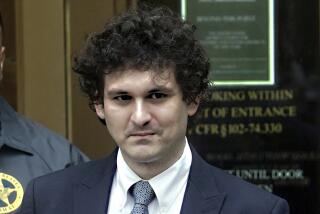VIEWPOINTS : What BankAmerica Can Do to Reverse Its Dangerous Course
- Share via
BankAmerica, on the heels of a shocking $640-million second-quarter loss, faces possibly the most difficult period in its 82-year history.
The loss, due largely to continuing problems with foreign, real estate, energy and farm loans at the company’s Bank of America unit, was the second largest in banking history and was unexpected, given that many analysts had thought the worst of the bank’s problems were over.
Now, BankAmerica faces a number of wrenching decisions. Should it sell assets and shrink? Should it undertake further cuts in personnel, which could save money but harm customer service? Should it raise new capital, and how? Should it change or restructure top management?
Meanwhile, the company must contend with possible takeover attempts while trying to maintain depositor confidence as observers wonder whether further losses are still ahead.
In an attempt to explore the various options facing BankAmerica, The Times invited bank consultants, investment analysts, academicians and investors to comment on what they think the bank’s management should do to turn the company around. Here are their comments:
BankAmerica, on the heels of a shocking $640-million second-quarter loss, faces possibly the most difficult period in its 82-year history.
The loss, due largely to continuing problems with foreign, real estate, energy and farm loans at the company’s Bank of America unit, was the second largest in banking history and was unexpected, given that many analysts had thought the worst of the bank’s problems were over.
Now, BankAmerica faces a number of wrenching decisions. Should it sell assets and shrink? Should it undertake further cuts in personnel, which could save money but harm customer service? Should it raise new capital, and how? Should it change or restructure top management?
Meanwhile, the company must contend with possible takeover attempts while trying to maintain depositor confidence as observers wonder whether further losses are still ahead.
In an attempt to explore the various options facing BankAmerica, The Times invited bank consultants, investment analysts, academicians and investors to comment on what they think the bank’s management should do to turn the company around. Here are their comments:
T. Rowe Price Associates, along with many other institutional investors and advisers, currently does not buy the debt securities of Bank of America or its parent, BankAmerica Corp., because of their relatively weak financial performance.
We believe that the bank will survive because of its strong core deposit base and the pressures on senior management to improve bank operations. However, before we could approve the bank for debt security purchases we would want to see the following developments take place:
- Improved loan quality.
Antiquated tracking systems and a poor management information system in the past restricted the ability of the bank to closely monitor the loan portfolio.
These systems, which management is currently addressing, allowed marginal loans to be made and problem loans to grow into larger problems. Senior management gave branch managers too much freedom in making loans and running their branch offices in the past, and the bank is paying the cost today for this freedom in the form of problem loans.
The bank has since reduced the amount of responsibility granted to branch managers, which we see as a good move.
The bank must also be even more aggressive in recognizing and making provisions for all its existing problem loans, even if that means more losses in the short run.
They should go ahead and bite the bullet and put all the bad loans behind them, so they can work toward the future with a clean slate.
- Continued control of non-interest expenses.
High non-interest expenses, such as for employees, branches and other overhead, reduced profitability in the past. The bank is controlling these expenses better today with branch bank closings and staff reductions.
But the firm must be even more aggressive with this cost cutting.
The company should not worry about being in every market and in every street corner, but should instead concentrate only on those operations and branches producing a profit. Branches and operations which are unprofitable should be closed.
Once these two areas are addressed successfully there will be the stronger, relative financial performance needed to attract many institutional managers, such as ourselves, back to buying the debt securities of the bank and its parent holding company.
More to Read
Inside the business of entertainment
The Wide Shot brings you news, analysis and insights on everything from streaming wars to production — and what it all means for the future.
You may occasionally receive promotional content from the Los Angeles Times.










